| Author | Message | ||
| ed_zeppelin
Advanced Member Username: ed_zeppelin Post Number: 335 Registered: 2-2010 |
His name was Gasparo Bertolotti, but as the greatest bassist of his age, he went by the rather spiffy "stage name" of "Gasparo da Salò." This is a 5-string bass he made in 1590, a half century before Stradivarius was even born: 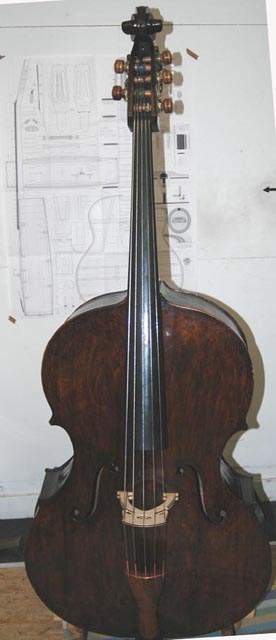  "Basses" didn't look like that before he came along. There were large boxes with strings on them, with names like "viola da Gamba" and "violones," but Gasparo was (arguably) the first to design and construct what's easily recognizable as a string bass. Queen Elizabeth I was still on the throne and had just defeated the Spanish Armada when that bass was made. The soundboard wood has been dated to the 13th century. Note that even though he used friction pegs in the pegbox, he was the first to handcraft individual geared metal machines to hold them in place. He also revolutionized the art of string-making (gut strings have always been made from sheep intestines, not cats) and made the northern Italian province/state of Brescia the center of European luthiery. He made that bass 30 years before the Black Plague wiped them all out (including most of his own) after which the Stradivarius, Amati and Guarneri families rose to prominence in Cremona.
There are only five Gasparo da Salò basses in existence. This one survived because as far as anyone can tell, in four and a half centuries it never ventured more than about twenty miles from where it was made. The reason I think Gasparo da Salò is worthy of inclusion to this esteemed, yet imaginary body is because like Alembic 400 years later, he started with sound, and it evolved from there. The real genius was in bringing beauty and form to the apex of excellence through instinct and innovation. Dude must have wanted to play bass really bad. Unfortunately, none of his music survives, because it was still being codified by Italian monks at the time, which is where all the Italian phrases in sheet music comes from. I'll bet he was a badass. Here's what a particularly monstrous behemoth he made sounds like: http://youtu.be/QB6Y3O6A4Fw | ||
| edwardofhuncote
Senior Member Username: edwardofhuncote Post Number: 951 Registered: 6-2014 |
That thing sounds positively incredible! Makes me want to restore my own "old" double-bass. It's been relegated to "furniture" status for a few years now, but before that it gave me that same feeling like the guy in the video talks about... it's like adding a sub-woofer to a nice stereo. Mine (also originally a 3-string) is only 150 years old +/- but that old wood really does sing when properly stressed. I would like to have met some of those Brescian makers, especially Maggini. (To me at least) his patterns are so much more distinctly recognizable (like an Alembic) than his contemporaries. And you gotta' think those guys were all learning from each other too, each trying to distinguish himself, but a specific sound in mind being the goal. More amazing to me, the basic design for a double-bass hasn't really changed that much in 400 years. | ||
| sonicus
Senior Member Username: sonicus Post Number: 4888 Registered: 5-2009 |
This is great ! Thanks for posting it . Wolf | ||
| ed_zeppelin
Advanced Member Username: ed_zeppelin Post Number: 336 Registered: 2-2010 |
I'm fascinated with the evolution of his ideas. Here's (the only pic I could find of) a 6-string fretted viola da gamba he made @1550. 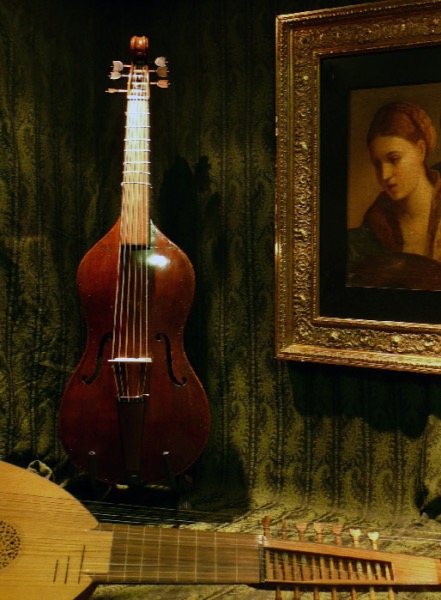 The thing in the foreground is an ill-tempered 27-string beast called a "liuto attiorbato." Like the sitar, the melody was supposed to be played on one string. It was considered a comic instrument and was mainly used by the narrator in skits and plays, as Romans had done with the lyre for thousands of years. Yes, we're looking at the earliest form of special effects, people. Note the identical pegs on both instruments. Here's a pic of the earliest known example of Gasparo's basses (@1560), a six-string partially-fretted violone at the Musical Instrument Museum in Rome. 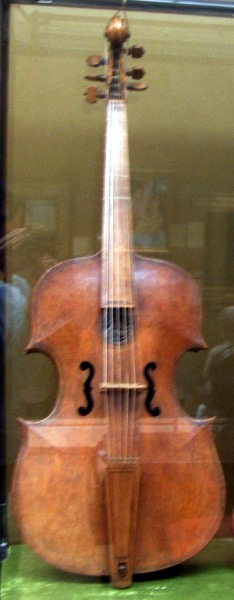 It sure gives you an idea of the amazing progress of his ideas, doesn't it? Friction pegs with no machines (my god, what a nightmare to tune. Good thing "temperament" was still just a theory at the time), the body shape ... wasn't ... And f-holes hadn't even been invented yet. I think the next evolution: reducing the size of shoulders and elongating the body somewhat so you could bow in front of the bridge instead of on it, were refinements! once he'd figured out how much real estate it was going to take to get the sound he was after. He was definitely trying to find the sound he was looking for. Interestingly, here's a viola made only a decade later:  There's the corners and f-holes that are still there to this day. There's some dispute about whether ol' man Amati or our hero came up with that stuff first. Anybody else notice that none of his instruments had ebony fingerboards? Ebony comes from Africa (at least, it did back then), which the Portuguese had dibs on. As far as violin family instruments at the time: nobody had thought of it yet. Note that the end of the fingerboard is attached to the soundboard. Last time you'll see that. For contrast, here's a viola from @1600:  Love the he-man carved on the tailpiece. Yeah, Gaspy. You da man. | ||
| edwardofhuncote
Senior Member Username: edwardofhuncote Post Number: 952 Registered: 6-2014 |
A couple basses of Gasparo da Salo's (best-known) student, Gio. Paolo Maggini survive as well. I would love to have played this one. http://doublebassguide.com/?p=569 One of the few things I picked up while figuring out I was never going to be a luthier... double-basses were often made by students as a lesson. (or perhaps a unique punishment?) The best information we could dig up on my old bass was that it was most likely the work of students at a violin-maker's school, somewhere in the (former) Czechoslovakian region of Bohemia. | ||
| ed_zeppelin
Advanced Member Username: ed_zeppelin Post Number: 337 Registered: 2-2010 |
I'd like to make a correction. Apparently the issue of "who done what first" is a big deal in Italy, considering it arises from the era of competing city/states and all that. So I was digging around last night for more information about how "they" figure out which instrument makers actually invented which features, when apparently everybody was stealing ideas from each other with abandon. The instrument bidness has always been like that, though. 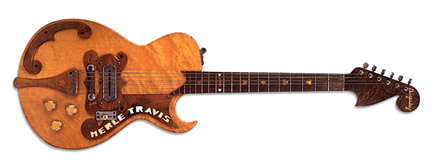 That guitar was made by a champion motorcycle racer named Paul Bigsby in 1948. Anything look familiar? I found this amazing site about Gasparo da Salò's viola da Gamba, pictured previously in my prior post. (Yeah, I'm a Dumas. I didn't realize there was a whole page that went along with that picture.) 
Well, that pretty much nails it, I'd say. Can't beat dendrochronilogicalestificationary evidence. So I must correct the date I cited earlier, to 1570. The amazing thing is that for the past 446 years, nearly every violin, viola, cello and string bass made by any luthier anywhere in the world has had f-holes that looked exactly like that. Including all of the violins and cellos of Stradivarius, Amati, Guarneri, Stainer, etc. Talk about getting it right the first time, huh? Imagine in the year 2525, somebody saying the same thing about the Alembic bridge. You know it's gonna happen. To give another perspective on where Gasparo was in his pursuit of the big thump, consider that his viola da Gamba was one of the largest instruments around at the time. Here are two Italian experts fighting over his viola da Gamba, to give you an idea of the size. The winner gets to run the country for a week or something.  (The violone at the museum in Rome isn't much bigger.) It was only twenty years between Gasparo's viola da Gamba and the behemoth in the video, or the 5-string bass in the OP. In the centuries that followed the viola da Gamba was replaced by the cello, which looks even more like a Gasparo da Salò instrument, ironically. At the time the Great Gaspy made that puppy, nobody made strings big enough for what he heard in his imagination, and friction pegs wouldn't hold them if they did. Nobody made a body with enough surface area for what he had in mind. And remember: he was known more for his playing than his instrument making skills during his lifetime, so he was driven to invent his own methods for making bigger strings than anybody had ever made before, and machines to secure the friction pegs, to anchor those strings across huge slabs of 300-year-old wood - by the same instinct that makes us want to strap on an Alembic and make the windows rattle. Gotta have that bass. That's where it all started, and nobody had been there before.
Did anybody else notice that the scrolls on the Great Gaspy's pegheads have an extra "curl?" | ||
| ed_zeppelin
Advanced Member Username: ed_zeppelin Post Number: 339 Registered: 2-2010 |
 Here's the full-sized picture. What's so amazing to me is that Maggini made that bass twenty years after Gasparo made the 5-string in the OP, which was made twenty years after the viola da Gamba, which was made roughly twenty years after the violone (like the dude said, Brescians didn't date their instruments). Yet Maggini's bass would look right at home in a modern orchestra, that's how little the string bass evolved over the ensuing four hundred years! This was the kind of thing Gasparo's contemporaries were creating at that time, @1550: 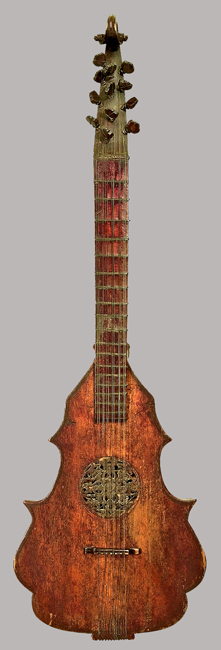 It kinda shows how quickly the art of thump evolved, and how beautifully it gradually evoked the female form. Maggini created that bass the year after Gasparo died, and 34 years before Antonio Stradivarius was born. Jamestown was founded (that's for any Virginians around here) on precisely the worst plot of land on the Eastern seaboard. A salt marsh the local natives considered cursed. For historical reference, 1610 was the year Polykarp Von Leyser the Elder died. No relevance, but you have to admit, that's a cool name. My teeth itch when I look at that bass, I wanna play it so bad. Aside from the odd heel, Maggini really finalized the form, didn't he? What I especially enjoy is the loving tribute to the female form. It's okay to notice. That's what "romance" means, y'know. The Italians were the ones who came up with the concept about that time, and music was the main expression of it. It's pretty easy to guess their source of inspiration. Take a look at Gasparo's violone again. The large shoulders were inspired by the sheer geometry of building ever-larger instruments, I think (the same way the earlier Gasparo viola looks like two bottom halves of violas stuck together, with a neck on one end). And like the 1600 viola, the shoulders softened, the bottom bouts widened, the waist moved north a mite and the neck got longer. I loved this, from the website for the Maggini bass:
And girlfriends. Lots of 'em. | ||
| ed_zeppelin
Advanced Member Username: ed_zeppelin Post Number: 341 Registered: 2-2010 |
I am blown away by the sound of Gasparo's Viola da Gamba. I had no idea how sublime it is. They say the cello most closely resembles the human voice, but my money's on Gaspy here. it really seems to be singing. http://youtu.be/YvpU3UYtVmI Interesting bow position, huh? Compared to what followed in his evolution toward the big thump we all know and love, I think this instrument was an experiment with sound that went horribly right. It's important to remember that his version of the viola da Gamba stuck around for centuries, pretty much unchanged. The cello evolved separately as orchestral music responded to changes in temperament and instrumentation, especially after JS Bach hit the scene. In the days before TV and radio, people came from far and wide for a viola da Gamba performance. "Dip the family in the pond and head for town! Yee haw!" (Would someone please run that through an Italian translator for me? Thanks!) I found a performance of Monteverdi's "Vespro della Beata Vergine" (1610) on period instruments, at the Palace of Versailles. The 6-string fretted viola da Gamba appears to be a copy of Gasparo's and the bass looks a lot like a Maggini (genie fo feeney banana fanna fo feeney, fee fi fo feeney), Maggini. http://youtu.be/S99FCAFNgaA It's amazing to consider that this was the music Gasparo heard in his head sixty years previously, when he created his viola da Gamba and turned to crafting the ensemble's lower register. Here's a Metropolitan Museum page about "archlutes." At @16:40 or so in that YouTube video is a great shot of the neck from behind, which answers the question: "how do you mount an 8-foot-long neck with umpteen strings on a lute body four centuries before the invention of the truss rod, without it imploding?" (20 laminates in the neck, that's how.) That one's just shy of 300 years old and seems to be doing fine, except for the slight starboard list. (Hell, you should see mine.) Can you imagine carting that damn thing around? "Oh my god, not another corner ... Bonk, ow! Oh no! A spiral staircase! BonkOW!bongbongbongbong BONK ..CRACK! Oh NO!" By the way, nobody would have dreamed of doing the "stank face" during a liturgical piece at that time, especially "Vespers" for the Virgin Mary. Those date back - unchanged - over 1500 years. Besides, everybody knew that kind of thing made the milk go bad and the crops fail. In an era where they still lit up the town square with burning people on a regular basis, it was probably best to keep a low profile. Here's a tip that will increase your enjoyment immensely when watching overwrought opera singers who look they're going into childbirth every time they open their mouths: imagine they're doing the same thing at both ends. It's kinda fun to note that the gilt "altar" Louis XIV installed has only one religious symbol at its core: his. I don't think I've ever seen a more extreme example of delusional narcissism in my life, until recently. | ||
| davehouck
Moderator Username: davehouck Post Number: 12112 Registered: 5-2002 |
Immergere la famiglia nello stagno e andare per la città! | ||
| davehouck
Moderator Username: davehouck Post Number: 12113 Registered: 5-2002 |
The Johanna Rose piece was nice; wonderful instrument that she seems to play very well. | ||
| davehouck
Moderator Username: davehouck Post Number: 12114 Registered: 5-2002 |
Viola da Gamba & Tiorba. |